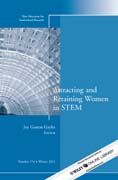
Attracting and retaining women in STEM: new directions for institutional research v. 152
Gayles, Joy Gaston
Underrepresentation of women in science, technology, engineering and mathematics fields is a problem that has persisted over the past three decades and ismost severe at the highest levels of the STEM career path. Although national attention has been directed toward increasing the presence of women in STEM, women continue to leave at critical junctures in STEM training and careers at a higher rate than men. This volume of New Directions for Institutional Research takes a comprehensive look at the status of women in STEM and considers related factors, theoretical perspectives, and innovative tools that have the potential to help scholars understand, study, and improve the experiences of women in STEM fields.This is the 152nd volume of New Directions for InstitutionalResearch. Always timely and comprehensive, New Directions for Institutional Research provides planners and administrators in all types of academic institutions with guidelines in such areas as resource coordination, information analysis, program evaluation, and institutional management. INDICE: Editor's Notes 1Joy Gaston Gayles1. Major Selection and Persistence for Women in STEM 5Casey A. Shapiro, Linda J. SaxThis chapter discusses key factors related to gender differences in selection and persistence in STEM fields of study. The chapter concludes with recommendations for institutional research and future studies on women's experiences in STEM majors on college campuses.2. Gender Matters: An Examination of Differential Effects of the College Experience on Degree Attainment in STEM 19Joy Gaston Gayles, Frim D. AmpawThischapter examines how the relationship between college experiences and degree attainment differs for men and women in STEM fi elds. On the basis of their findings, the authors provide recommendations for future research on studying the college experience for women in STEM.3. Living-Learning Programs for Women in STEM 27Karen Kurotsuchi InkelasLiving-learning programs for women in STEM exist in various forms on college campuses across the country. This chapter offers an overview of the role and functions of living-learning programs and summarizes empirical evidence on living-learning communities’ effectiveness in retaining women in STEM.4. The Role of Community Colleges in Educating Women in Science and Engineering 39Dimitra Lynette Jackson, Frankie Santos LaananCommunity colleges have the potential to serve as a major gateway for educating the next generation of female scientists. The authors of this chapter share the results from a mixed-methods study that examined the experiences of female students in STEM who transferred from the community college system.5. The Postbaccalaureate Goals of College Women in STEM 51Darnell Cole, Araceli EspinozaEquallyimportant as attracting and retaining women in science is the extent to whichthey persist in science careers after graduation. Using social cognitive career theory as a guiding framework, the authors summarize the results from a study on the postbaccalaureate goals of women in STEM.6. Understanding the Factors Affecting Degree Completion of Doctoral Women in the Science and EngineeringFields 59Frim D. Ampaw, Audrey J. JaegerUnderrepresentation of women in STEM is prevalent in graduate education, and the problem extends to women in faculty ranks. The low representation of women in science is prevalent and extends to the faculty as well. This chapter summarizes the fi ndings from a study thatexamined pathways to the professoriate for female graduate students in STEM.7. Women of Color in Science, Technology, Engineering, and Mathematics (STEM) 75Dawn R. JohnsonOne of the challenges in studying the experiences of women in STEM involves treating women as a homogeneous group, which obscures important racial and ethnic differences. This chapter highlights the importance of addressing intersecting identities in research on women in STEM.8. New Tools for Examining Undergraduate Students' STEM Stereotypes: Implications for Women and Other Underrepresented Groups 87Sylvia C. Nassar-McMillan, Mary Wyer, Maria Oliver-Hoyo, Jennifer SchneiderIn this chapter, the authors discuss the measurement development process for three assessment tools designed to gauge how individuals perceive scientists. From the results of this fi ve-year NSF-funded project, implications are offered for institutional research and practice.INDEX 99
- ISBN: 978-1-118-29769-8
- Editorial: John Wiley & Sons
- Encuadernacion: Rústica
- Páginas: 112
- Fecha Publicación: 11/01/2012
- Nº Volúmenes: 1
- Idioma: Inglés
